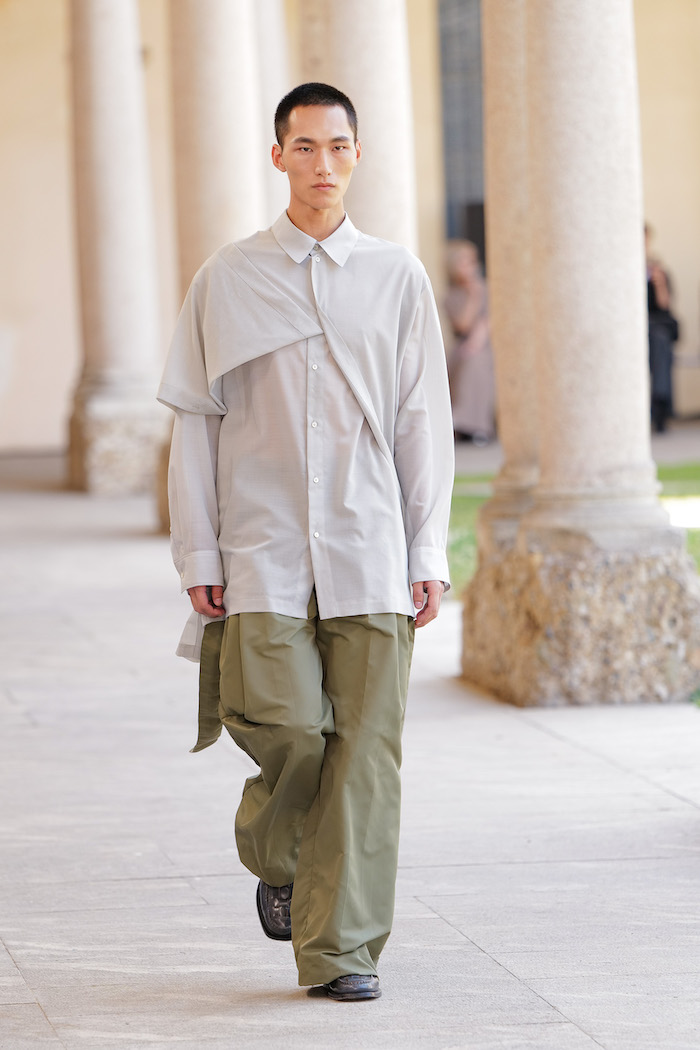 |
| The evocative Qasimi collection was launched in the ancient cloisters of a former monastery in Milan. Photograph: Andrea Heinsohn for DAM |
In a city known for grand fashion gestures, Qasimi took a quieter, more contemplative path for its Spring/Summer 2026 collection, staging its 10th anniversary show in the atmospheric cloisters of Sant’Eustorgio, a place steeped in centuries of Milanese history. Surrounded by Doric columns and soaring archways, the collection, designed by Hoor Al-Qasimi with a collaboration with artist Dala Nasser, was layered, textured and subtly powerful, writes Jeanne-Marie Cilento. Photography by Andrea Heinsohn
 |
The historic cloisters as a backdrop to the show added another layer of meaning to the collection |
The setting with its centuries of spiritual and architectural
history added unexpected depth to a collection already steeped in thoughts about time, impermanence, and resilience.
Located in one of Milan’s most sacred historical quarters, the Cloisters of Sant’Eustorgio date back to the 13th century, when they served as the city’s first Dominican monastery. From the Spanish-French conflicts in the 16th century to air raids in World War II, today they are restored and serene, the cloisters standing as silent witnesses to endurance.
The designer brings nuance, political awareness and a poetic use of materials to the new collection
 |
Nasser's installation infused the show with raw emotion, weathered textiles catching the wind. |
The installation, a ring of scaffolding veiled in weathered textile, was the work of Lebanese artist Dala Nasser, whose collaboration this season went beyond set design. Known for her site-responsive, material-driven practice, Nasser infused the show with a raw, textural sensitivity that shaped both environment and designs.
Grounded in Qasim's hallmark palette of sandy tones, clay browns, and sun-bleached pinks, the Spring/Summer 2026 collection presented a restrained but expressive range. The materials told the story as much as the shapes did, chief among them, 'memory nylon', a fabric that retains the folds and creases of its wearer before gradually softening, like memory itself fading with time. This concept of impermanence ran through the collection, most notably in outerwear and tailoring that looked aged, softened, and lived in.
The utilitarian ethos is softened by pocketed vests elongated into tunics, mohair knits decorated with stones and collarless jackets floating over pleated trousers
 |
Long tunics had raw hems and loose threads inspired by Dala Nasser, |
For menswear, Al-Qasimi softened the
brand’s utilitarian ethos: pocketed vests were elongated into tunics, mohair
knits were decorated with stones and buttons like treasures retrieved from the
earth, and collarless jackets floated over pleated trousers.
Nasser’s touch was most visible in the finishing details. Loose threads, doodle-style embroidery, and raw hems echoed the marks of time and erosion found in her artworks, many of which draw from Lebanon’s decaying landscapes and architectural ruins. These elements, woven into the collection with restraint, offered a tactile reflection on the fragility and strength of heritage.
Accessories continued the narrative. Crocheted keychains
shaped like hybrid animals nodded to ideas of blended identities and evolving
forms, while the incorporation of surplus materials underscored the brand’s
growing commitment to sustainability and circular design. Every piece felt
considered, not only in construction but in meaning, adding to the show’s intellectual tone.
Nasser’s touch was most visible in the loose threads, doodle-style embroidery, and raw hems echoing the marks of time and erosion found in her artworks
 |
The palette of subtle colours in rose, sand, cream and pale blue suggested the timeworn. . |
Since taking over the label in 2019 following the loss of her brother and Qasimi founder Khalid Al Qasimi, Hoor Al-Qasimi has brought a thoughtful direction to the house. Rather than relying on loud gestures, she continues to build a language rooted in nuance, political awareness, and a poetic use of materials.
In a city and season often dominated by spectacle, Qasimi's
Spring/Summer 2026 stood apart for its sense of stillness. The show didn’t need
to shout. It whispered ~ across centuries, across cultures, and through each stitched thread.
Scroll down to see more highlights from the Qasim Spring/Summer collection in Milan
























